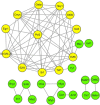Transcriptional regulation and spatial interactions of head-to-head genes
- PMID: 24962804
- PMCID: PMC4089025
- DOI: 10.1186/1471-2164-15-519
Transcriptional regulation and spatial interactions of head-to-head genes
Abstract
Background: In eukaryotic genomes, about 10% of genes are arranged in a head-to-head (H2H) orientation, and the distance between the transcription start sites of each gene pair is closer than 1 kb. Two genes in an H2H pair are prone to co-express and co-function. There have been many studies on bidirectional promoters. However, the mechanism by which H2H genes are regulated at the transcriptional level still needs further clarification, especially with regard to the co-regulation of H2H pairs. In this study, we first used the Hi-C data of chromatin linkages to identify spatially interacting H2H pairs, and then integrated ChIP-seq data to compare H2H gene pairs with and without evidence of spatial interactions in terms of their binding transcription factors (TFs). Using ChIP-seq and DNase-seq data, histones and DNase associated with H2H pairs were identified. Furthermore, we looked into the connections between H2H genes in a human co-expression network.
Results: We found that i) Similar to the behaviour of two genes within an H2H pair (intra-H2H pair), a gene pair involving two distinct H2H pairs (inter-H2H pair) which interact with each other spatially, share common transcription factors (TFs); ii) TFs of intra- and inter-H2H pairs are distributed differently. Factors such as HEY1, GABP, Sin3Ak-20, POL2, E2F6, and c-MYC are essential for the bidirectional transcription of intra-H2H pairs; while factors like CTCF, BDP1, GATA2, RAD21, and POL3 play important roles in coherently regulating inter-H2H pairs; iii) H2H gene blocks are enriched with hypersensitive DNase and modified histones, which participate in active transcriptions; and iv) H2H genes tend to be highly connected compared with non-H2H genes in the human co-expression network.
Conclusions: Our findings shed new light on the mechanism of the transcriptional regulation of H2H genes through their linear and spatial interactions. For intra-H2H gene pairs, transcription factors regulate their transcriptions through bidirectional promoters, whereas for inter-H2H gene pairs, transcription factors are likely to regulate their activities depending on the spatial interaction of H2H gene pairs. In this way, two distinctive groups of transcription factors mediate intra- and inter-H2H gene transcriptions respectively, resulting in a highly compact gene regulatory network.
Figures






Similar articles
-
Pan-Cancer Analysis of Head-to-Head Gene Pairs in Terms of Transcriptional Activity, Co-expression and Regulation.Front Genet. 2021 Jan 7;11:560997. doi: 10.3389/fgene.2020.560997. eCollection 2020. Front Genet. 2021. PMID: 33488665 Free PMC article.
-
Sorting out inherent features of head-to-head gene pairs by evolutionary conservation.BMC Bioinformatics. 2010 Dec 14;11 Suppl 11(Suppl 11):S16. doi: 10.1186/1471-2105-11-S11-S16. BMC Bioinformatics. 2010. PMID: 21172051 Free PMC article.
-
A study on promoter characteristics of head-to-head genes in Saccharomyces cerevisiae.BMC Genomics. 2012;13 Suppl 1(Suppl 1):S11. doi: 10.1186/1471-2164-13-S1-S11. Epub 2012 Jan 17. BMC Genomics. 2012. PMID: 22369481 Free PMC article.
-
The dual lives of bidirectional promoters.Biochim Biophys Acta. 2012 Jul;1819(7):688-93. doi: 10.1016/j.bbagrm.2012.02.006. Epub 2012 Feb 21. Biochim Biophys Acta. 2012. PMID: 22366276 Free PMC article. Review.
-
Modeling bidirectional transcription using silkmoth chorion gene promoters.Organogenesis. 2010 Jan-Mar;6(1):54-8. doi: 10.4161/org.6.1.10696. Organogenesis. 2010. PMID: 20592866 Free PMC article. Review.
Cited by
-
Pan-Cancer Analysis of Head-to-Head Gene Pairs in Terms of Transcriptional Activity, Co-expression and Regulation.Front Genet. 2021 Jan 7;11:560997. doi: 10.3389/fgene.2020.560997. eCollection 2020. Front Genet. 2021. PMID: 33488665 Free PMC article.
-
Molecular models of bidirectional promoter regulation.Curr Opin Struct Biol. 2024 Aug;87:102865. doi: 10.1016/j.sbi.2024.102865. Epub 2024 Jun 20. Curr Opin Struct Biol. 2024. PMID: 38905929 Free PMC article. Review.
-
Predicting Protein Function in the AI and Big Data Era.Biochemistry. 2025 Jun 3;64(11):2345-2352. doi: 10.1021/acs.biochem.5c00186. Epub 2025 May 17. Biochemistry. 2025. PMID: 40380914 Free PMC article. Review.
-
The AP2/ERF transcription factor GmTINY mediates ethylene regulation of Rhg1-conferred resistance against soybean cyst nematode.Plant Commun. 2025 Jul 14;6(7):101378. doi: 10.1016/j.xplc.2025.101378. Epub 2025 May 19. Plant Commun. 2025. PMID: 40394901 Free PMC article.
-
Analysis of Co-Associated Transcription Factors via Ordered Adjacency Differences on Motif Distribution.Sci Rep. 2017 Feb 27;7:43597. doi: 10.1038/srep43597. Sci Rep. 2017. PMID: 28240320 Free PMC article.
References
Publication types
MeSH terms
Substances
LinkOut - more resources
Full Text Sources
Other Literature Sources

